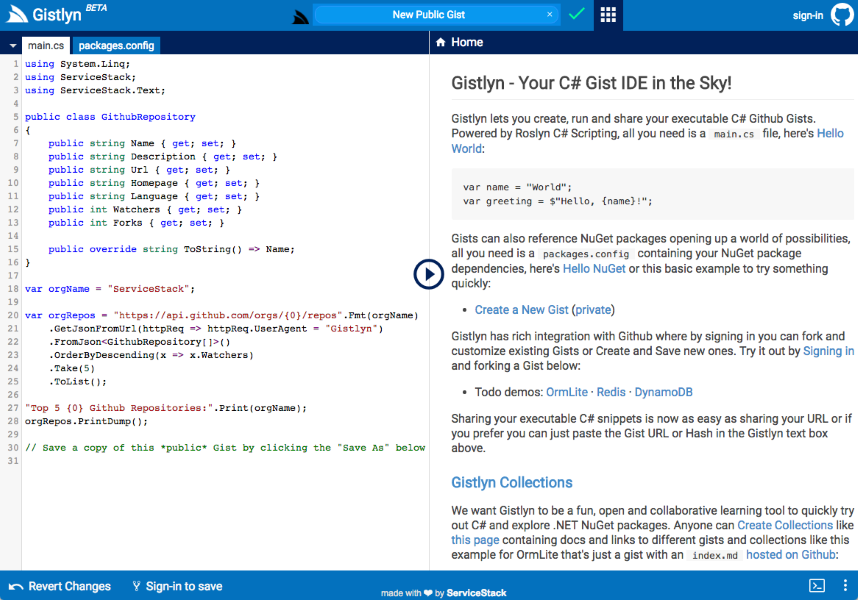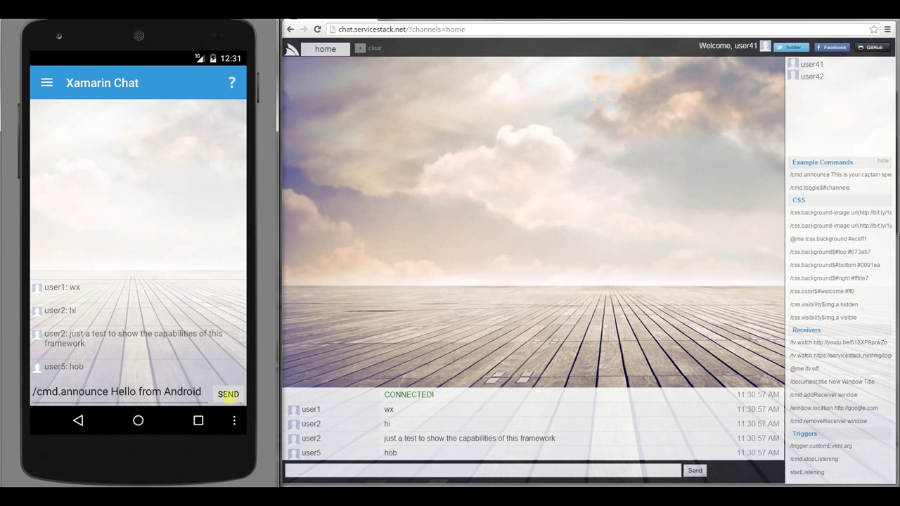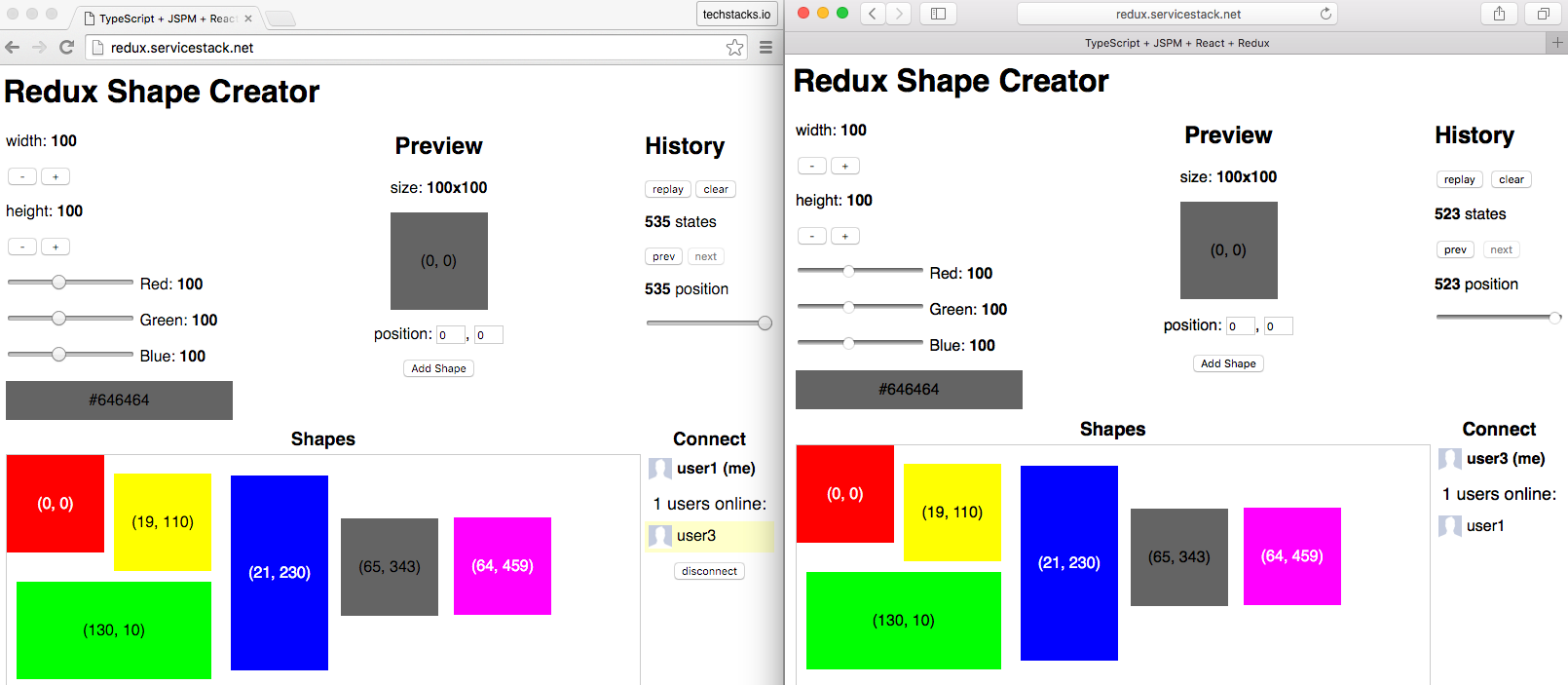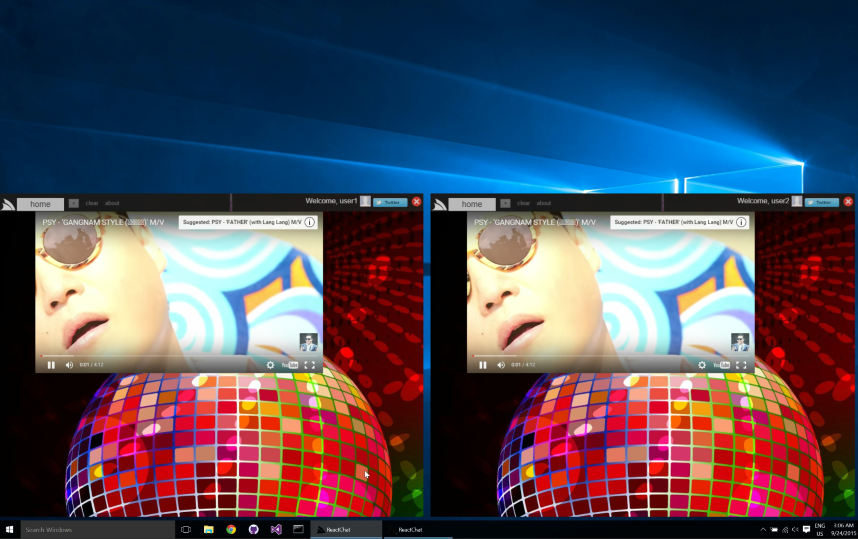Server Events
This page has moved to docs.servicestack.net/server-events
Server Sent Events (SSE) is an elegant web technology for efficiently receiving push notifications from any HTTP Server. It can be thought of as a mix between long polling and one-way WebSockets and contains many benefits over each:
- Simple - Server Sent Events is just a single long-lived HTTP Request that any HTTP Server can support
- Efficient - Each client uses a single TCP connection and each message avoids the overhead of HTTP Connections and Headers that's often faster than Web Sockets.
- Resilient - Browsers automatically detect when a connection is broken and automatically reconnects
- Interoperable - As it's just plain-old HTTP, it's introspectable with your favorite HTTP Tools and even works through HTTP proxies (with buffering and chunked-encoding turned off).
- Well Supported - As a Web Standard it's supported in all major browsers except for IE which can be enabled with polyfills - see default_ieshim.cshtml and its Live Chat Example.
We've chosen to adopt Server Sent Events for Server Notifications as it's a beautifully simple and elegant Web Standard with better HTTP fidelity than WebSockets, that's perfect fit for Server Push Communications that works in both ServiceStack' ASP.NET and SelfHosts without requiring any extra .NET dependencies or require the host Windows Server have WebSockets support to use.
- Memory Server Events (default)
- Redis Server Events
Like most other modular functionality in ServiceStack, Server Sent Events is encapsulated in a single Plugin that can be registered in your AppHost with:
Plugins.Add(new ServerEventsFeature());The registration above is all that's needed for most use-cases which just uses the defaults below:
class ServerEventsFeature
{
StreamPath = "/event-stream"; // The entry-point for Server Sent Events
HeartbeatPath = "/event-heartbeat"; // Where to send heartbeat pulses
UnRegisterPath = "/event-unregister"; // Where to unregister your subscription
SubscribersPath = "/event-subscribers"; // View public info of channel subscribers
// Return `401 Unauthorized` to non-authenticated clients
LimitToAuthenticatedUsers = false;
// How long to wait for heartbeat before unsubscribing
IdleTimeout = TimeSpan.FromSeconds(30);
// Client Interval for sending heartbeat messages
HeartbeatInterval = TimeSpan.FromSeconds(10);
// Send notifications when subscribers join/leave
NotifyChannelOfSubscriptions = true;
}The paths allow you to customize the routes for the built-in Server Events API's, whilst setting either path to
nulldisables that feature.
There are also a number of hooks available providing entry points where custom logic can be added to modify or enhance existing behavior:
class ServerEventsFeature
{
//Filter OnConnect messages
Action<IEventSubscription, Dictionary<string, string>> OnConnect;
// Events fired when
Action<IEventSubscription, IRequest> OnCreated; // Subscription is created
Action<IEventSubscription> OnSubscribe; // Subscription is registered
Action<IEventSubscription> OnUnsubscribe; // Subscription is unregistered
}The way your Services send notifications is via the IServerEvents API which defaults to an in-memory MemoryServerEvents implementation which keeps a record of all subscriptions and connections in memory:
Server Events can also be configured to use a distributed Redis backend which allows Server Events to work across load-balanced app servers.
public interface IServerEvents : IDisposable
{
// External API's
void NotifyAll(string selector, object message);
void NotifyChannel(string channel, string selector, object message);
void NotifySubscription(string subscriptionId, string selector, object message, string channel = null);
void NotifyUserId(string userId, string selector, object message, string channel = null);
void NotifyUserName(string userName, string selector, object message, string channel = null);
void NotifySession(string sspid, string selector, object message, string channel = null);
SubscriptionInfo GetSubscriptionInfo(string id);
List<SubscriptionInfo> GetSubscriptionInfosByUserId(string userId);
// Admin API's
void Register(IEventSubscription subscription, Dictionary<string, string> connectArgs = null);
void UnRegister(string subscriptionId);
long GetNextSequence(string sequenceId);
int RemoveExpiredSubscriptions();
void SubscribeToChannels(string subscriptionId, string[] channels);
void UnsubscribeFromChannels(string subscriptionId, string[] channels);
// Client API's
List<Dictionary<string, string>> GetSubscriptionsDetails(params string[] channels);
List<Dictionary<string, string>> GetAllSubscriptionsDetails();
bool Pulse(string subscriptionId);
// Clear all Registrations
void Reset();
void Start();
void Stop();
}The API's your Services predominantly deal with are the External API's which allow sending of messages at different levels of granularity. As Server Events have deep integration with ServiceStack's Sessions and Authentication Providers you're also able to notify specific users by either:
NotifyUserId() // UserAuthId
NotifyUserName() // UserName
NotifySession() // Session IdWhilst these all provide different ways to send a message to a single authenticated user, any user can be connected to multiple subscriptions at any one time (e.g. by having multiple tabs open). Each one of these subscriptions is uniquely identified by a subscriptionId which you can send a message with using:
NotifySubscription() // Unique Subscription IdThere are also API's to retrieve a users single event subscription as well as all subscriptions for a user:
SubscriptionInfo GetSubscriptionInfo(string id);
List<SubscriptionInfo> GetSubscriptionInfosByUserId(string userId);An Event Subscription allows you to inspect different metadata contained on each subscription as well as being able to Publish() messages directly to it, manually send a Heartbeat Pulse() (to keep the connection active) as well as Unsubscribe() to revoke the subscription and terminate the HTTP Connection.
public interface IEventSubscription : IMeta, IDisposable
{
DateTime CreatedAt { get; set; }
DateTime LastPulseAt { get; set; }
string Channel { get; }
string UserId { get; }
string UserName { get; }
string DisplayName { get; }
string SessionId { get; }
string SubscriptionId { get; }
bool IsAuthenticated { get; set; }
Action<IEventSubscription> OnUnsubscribe { get; set; }
void Unsubscribe();
void Publish(string selector, object message);
void Pulse();
}The IServerEvents API also offers an API to UnRegister a subscription with:
void UnRegister(IEventSubscription subscription);Standard Publish / Subscribe patterns include the concept of a Channel upon which to subscribe and publish messages to. The channel in Server Events can be any arbitrary string which is declared on the fly when it's first used.
As Request DTO names are unique in ServiceStack they also make good channel names which benefit from providing a typed API for free, e.g:
typeof(Request).Name.
The API to send a message to a specific channel is:
void NotifyChannel(string channel, string selector, object message);Which just includes the name of the channel, the selector you wish the message applies to and the message to send which can be any JSON serializable object.
Along with being able to send a message to everyone on a channel, each API also offers an optional channel filter which when supplied will limit messages only to that channel:
void NotifyUserId(string userId, string selector, object message, string channel = null);The following Server and Client callbacks are fired when a client first makes a Server Events Connection:
-
ServerEventsFeature.OnInit()- Fired when the server receives the initial HTTP connection. This callback can be used to customize any HTTP Headers that are sent back to the client -
ServerEventsFeature.OnCreated()- Fired when the serverIEventSubscriptionis created but before it becomes Connected. -
ServerEventsFeature.OnConnect()- Fired when theIEventSubscriptionis about to be connected. This callback can be used to modify the connection info arguments the client receives -
(Client) - The Client is then sent an
cmd.onConnectmessage with the connection info arguments about the connection. -
ServerEventsFeature.OnSubscribe()- Fired after the subscription is registered. This callback can be used to send any custom messages to the client -
(Client) - If
ServerEventsFeature.NotifyChannelOfSubscriptions = trueevery client in the same channel receives acmd.onJoinmessage to notify them that a new subscription has joined the channel as well as acmd.onLeavemessage when subscription leaves the channel
The
cmd.onConnect,cmd.onJoinandcmd.onLeavemessages can be handled with the Global Event Handlers on the JavaScript Client and the Message Event Handlers or the Global Receiver .NET ServerEventClient.
Periodically whilst the client maintains a ServerEvents subscription with the server it will send periodic Heartbeats to the Server. This will fire the ServerEventsFeature.OnHeartbeatInit() server event which if the client is still connected will be sent a cmd.onHeartbeat message. If the subscription no longer exists, heartbeats will return a 404 - Subscription {id} does not exist HTTP Response.
The implementation of Chat is a great way to explore different Server Event features which make it easy to develop highly interactive and responsive web apps with very little effort.
One feature common to chat clients is to get details of all the active subscribers in a channel which we can get from the built-in /event-subscribers route, e.g:
$.getJSON("/event-subscribers?channel=@channel", function (users) {
$.map(users, function(user) {
usersMap[user.userId] = user;
refCounter[user.userId] = (refCounter[user.userId] || 0) + 1;
});
var html = $.map(usersMap, function(user) { return createUser(user); }).join('');
$("#users").html(html);
});As a single user can have multiple subscriptions (e.g. multiple tabs open) users are merged into a single usersMap so each user is only listed once in the users list and a refCounter is maintained with the number of subscriptions each user has, so we're able to tell when the user has no more active subscriptions and can remove them from the list.
Chat's text box provides a free-text entry input to try out different Server Event features where each text message is posted to a ServiceStack Service which uses the IServerEvents API to send notifications the channels subscribers. When a server event is received on the client, the ss-utils.js client bindings routes the message to the appropriate handler. As all messages go through this same process, the moment the log entry appears in your chat window is also when it appears for everyone else (i.e instant when running localhost).
Normal chat messages (i.e. that don't specify a selector) uses the default cmd.chat selector which is sent to the chat handler that just echoes the entry into the chat log with:
chat: function (m, e) {
addEntry({ id: m.id, userId: m.fromUserId, userName: m.fromName, msg: m.message,
cls: m.private ? ' private' : '' });
}You can specify to use an alternative selector by prefixing the message with a /{selector}, e.g:
/cmd.announce This is your captain speaking ...
When a selector is specified in Chat it routes the message to the /channels/{Channel}/raw Service which passes the raw message through as a string. Normal Chat entries are instead posted to the /channels/{Channel}/chat Service, adding additional metadata to the chat message with the user id and name of the sender so it can be displayed in the chat log. The Javascript code that calls both Services is simply:
if (msg[0] == "/") {
parts = $.ss.splitOnFirst(msg, " ");
$.post("/channels/@channel/raw",
{ from: activeSub.id, toUserId: to, message: parts[1], selector: parts[0].substring(1) });
} else {
$.post("/channels/@channel/chat",
{ from: activeSub.id, toUserId: to, message: msg, selector: "cmd.chat" });
}Another special syntax supported in Chat is the ability to send messages to other users by prefixing it with @ followed by the username, e.g:
@mythz this is a private message
@mythz /tv.watch http://youtu.be/518XP8prwZo
There's also a special @me alias to send a message to yourself, e.g:
@me /tv.watch http://youtu.be/518XP8prwZo
By default ServiceStack doesn't expose any Services that can send notifications to other users by default. It's left up to your application as to what functionality and level of granularity should be enabled for your Application. Your Services can send notifications via the IServerEvents provider.
Below is the annotated implementation for both Web Services used by Chat. The PostRawToChannel is a simple implementation that just relays the message sent to all users in the channel or just a specific user if ToUserId parameter is specified.
The PostChatToChannel Service is used for sending Chat messages which sends a wrapped ChatMessage DTO instead that holds additional metadata about the message that the Chat UI requires:
[Route("/channels/{Channel}/chat")]
public class PostChatToChannel : IReturn<ChatMessage>
{
public string From { get; set; }
public string ToUserId { get; set; }
public string Channel { get; set; }
public string Message { get; set; }
public string Selector { get; set; }
}
[Route("/channels/{Channel}/raw")]
public class PostRawToChannel : IReturnVoid
{
public string From { get; set; }
public string ToUserId { get; set; }
public string Channel { get; set; }
public string Message { get; set; }
public string Selector { get; set; }
}
public class ServerEventsServices : Service
{
public IServerEvents ServerEvents { get; set; }
public IChatHistory ChatHistory { get; set; }
public IAppSettings AppSettings { get; set; }
public void Any(PostRawToChannel request)
{
if (!IsAuthenticated && AppSettings.Get("LimitRemoteControlToAuthenticatedUsers", false))
throw new HttpError(HttpStatusCode.Forbidden, "You must be authenticated to use remote control.");
// Ensure the subscription sending this notification is still active
var sub = ServerEvents.GetSubscriptionInfo(request.From);
if (sub == null)
throw HttpError.NotFound("Subscription {0} does not exist".Fmt(request.From));
// Check to see if this is a private message to a specific user
if (request.ToUserId != null)
{
// Only notify that specific user
ServerEvents.NotifyUserId(request.ToUserId, request.Selector, request.Message);
}
else
{
// Notify everyone in the channel for public messages
ServerEvents.NotifyChannel(request.Channel, request.Selector, request.Message);
}
}
public object Any(PostChatToChannel request)
{
// Ensure the subscription sending this notification is still active
var sub = ServerEvents.GetSubscriptionInfo(request.From);
if (sub == null)
throw HttpError.NotFound("Subscription {0} does not exist".Fmt(request.From));
var channel = request.Channel;
// Create a DTO ChatMessage to hold all required info about this message
var msg = new ChatMessage
{
Id = ChatHistory.GetNextMessageId(channel),
FromUserId = sub.UserId,
FromName = sub.DisplayName,
Message = request.Message,
};
// Check to see if this is a private message to a specific user
if (request.ToUserId != null)
{
// Mark the message as private so it can be displayed differently in Chat
msg.Private = true;
// Send the message to the specific user Id
ServerEvents.NotifyUserId(request.ToUserId, request.Selector, msg);
// Also provide UI feedback to the user sending the private message so they
// can see what was sent. Relay it to all senders active subscriptions
var toSubs = ServerEvents.GetSubscriptionInfosByUserId(request.ToUserId);
foreach (var toSub in toSubs)
{
// Change the message format to contain who the private message was sent to
msg.Message = "@{0}: {1}".Fmt(toSub.DisplayName, msg.Message);
ServerEvents.NotifySubscription(request.From, request.Selector, msg);
}
}
else
{
// Notify everyone in the channel for public messages
ServerEvents.NotifyChannel(request.Channel, request.Selector, msg);
}
if (!msg.Private)
ChatHistory.Log(channel, msg);
return msg;
}
}You can update a live Server Events connection with Channels you want to Join or Leave using the
built-in ServerEvents UpdateEventSubscriber Service:
[Route("/event-subscribers/{Id}", "POST")]
public class UpdateEventSubscriber : IReturn<UpdateEventSubscriberResponse>
{
public string Id { get; set; }
public string[] SubscribeChannels { get; set; }
public string[] UnsubscribeChannels { get; set; }
}This lets you modify your active subscription with channels you want to join or leave with a HTTP POST Request, e.g:
POST /event-subscribers/{subId}
SubscribeChannels=chan1,chan2&UnsubscribeChannels=chan3,chan4
As this modifies the active subscription it also publishes a new onUpdate notification to all channel subscribers so they're able to maintain up-to-date info on each subscriber.
In C# ServerEventsClient this can be handled together with onJoin and onLeave events using OnCommand:
client.OnCommand = msg => ...; //= ServerEventJoin, ServerEventLeave or ServerEventUpdateIn the ss-utils JavaScript Client this can be handled with a Global Event Handler, e.g:
$(source).handleServerEvents({
handlers: {
onConnect: connectedUserInfo => { ... },
onJoin: userInfo => { ... },
onLeave: userInfo => { ... },
onUpdate: userInfo => { ... }
}
});Whilst internally, from within ServiceStack you can update a channel's subscription using the IServerEvents APIs:
public interface IServerEvents
{
...
void SubscribeToChannels(string subscriptionId, string[] channels);
void UnsubscribeFromChannels(string subscriptionId, string[] channels);
}If your web server is configured to automatically buffer the response it will delay when the Server Events get sent to the client. In IIS Express you can disable buffering by disabling compression for dynamic requests by adding this to your Web.config:
<system.webServer>
<urlCompression doStaticCompression="true" doDynamicCompression="false" />
</system.webServer>Alternatively you can switch to use Visual Studio Development Server which doesn't buffer by default.
Gistlyn is a C# Gist IDE for creating, running and sharing stand-alone, executable C# snippets.
React Chat is a port of ServiceStack Chat ES5, jQuery Server Events demo into a TypeScript, React and Redux App:
Xamarin.Android Chat utilizes the .NET PCL Server Events Client to create an Android Chat App connecting to the existing chat.servicestack.net Server Events back-end where it's able to communicate with existing Ajax clients and other connected Android Chat Apps.
A network-enhanced version of the stand-alone Time Traveller Shape Creator that allows users to connect to and watch other users using the App in real-time similar to how users can use Remote Desktop to watch another computer's screen:
Live demo: http://redux.servicestack.net
Feature-rich Single Page Chat App, showcasing Server Events support in 170 lines of JavaScript!
Built with React Desktop Apps VS.NET template and packaged into a native Desktop App for Windows and OSX - showcasing synchronized real-time control of multiple Windows Apps:
Downloads for Windows, OSX, Linux and Web
- Why ServiceStack?
- Important role of DTOs
- What is a message based web service?
- Advantages of message based web services
- Why remote services should use separate DTOs
-
Getting Started
-
Designing APIs
-
Reference
-
Clients
-
Formats
-
View Engines 4. Razor & Markdown Razor
-
Hosts
-
Security
-
Advanced
- Configuration options
- Access HTTP specific features in services
- Logging
- Serialization/deserialization
- Request/response filters
- Filter attributes
- Concurrency Model
- Built-in profiling
- Form Hijacking Prevention
- Auto-Mapping
- HTTP Utils
- Dump Utils
- Virtual File System
- Config API
- Physical Project Structure
- Modularizing Services
- MVC Integration
- ServiceStack Integration
- Embedded Native Desktop Apps
- Auto Batched Requests
- Versioning
- Multitenancy
-
Caching
-
HTTP Caching 1. CacheResponse Attribute 2. Cache Aware Clients
-
Auto Query
-
AutoQuery Data 1. AutoQuery Memory 2. AutoQuery Service 3. AutoQuery DynamoDB
-
Server Events
-
Service Gateway
-
Encrypted Messaging
-
Plugins
-
Tests
-
ServiceStackVS
-
Other Languages
-
Amazon Web Services
-
Deployment
-
Install 3rd Party Products
-
Use Cases
-
Performance
-
Other Products
-
Future





